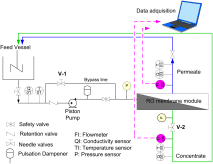Últimas investigaciones:
Proyecto de investigación co-edu: Competencias transversales desde la EIIC para su ecosistema social11 Dic 2022
Carreteras sostenibles con geomateriales volcánicos
28 Jul 2022
Competencias transversales desde la EIIC para su ecosistema social
1 Jun 2022
Benefits of inclined pile foundations in earthquake resistant design of bridges
30 Dic 2019
Groundwater Quality Assessment in a Volcanic Mountain Range (South of Gran Canaria Island, Spain)
11 Abr 2019
Ir a investigación

1 Ago 2018
Combined silica and sodium alginate fouling of spiral-wound reverse osmosis membranes for seawater desalination
Abstract
Reverse osmosis efficiency depends on the precise prediction, among other factors, of membrane fouling. Although extensive research has been devoted to single foulants, rather less attention has been paid to simultaneous foulants which are more representative of real feed solutions. The main purpose of this research was therefore to characterize and quantify the fouling potential that results from the coexistence of simultaneous foulants. Silica and sodium alginate were used as respective models of inorganic and organic colloidal foulants. In order to understand the possible interactions, membrane fouling was first forced with a single foulant and the results compared to combined fouling. The experiments were carried out under constant pressure and employed synthetic seawater with 32 g/L of NaCl in a pilot-scale reverse osmosis unit. A standard commercial spiral-wound thin-film composite membrane was used. The results showed a more aggravated permeate flux decline in the combined fouling experiments. An exacerbated synergistic effect on membrane fouling was observed when the concentration of sodium alginate was equal to or higher than the concentration of silica. In these cases, the permeate flux decline of combined fouling was more severe than the sum of flux decline of individual foulants.